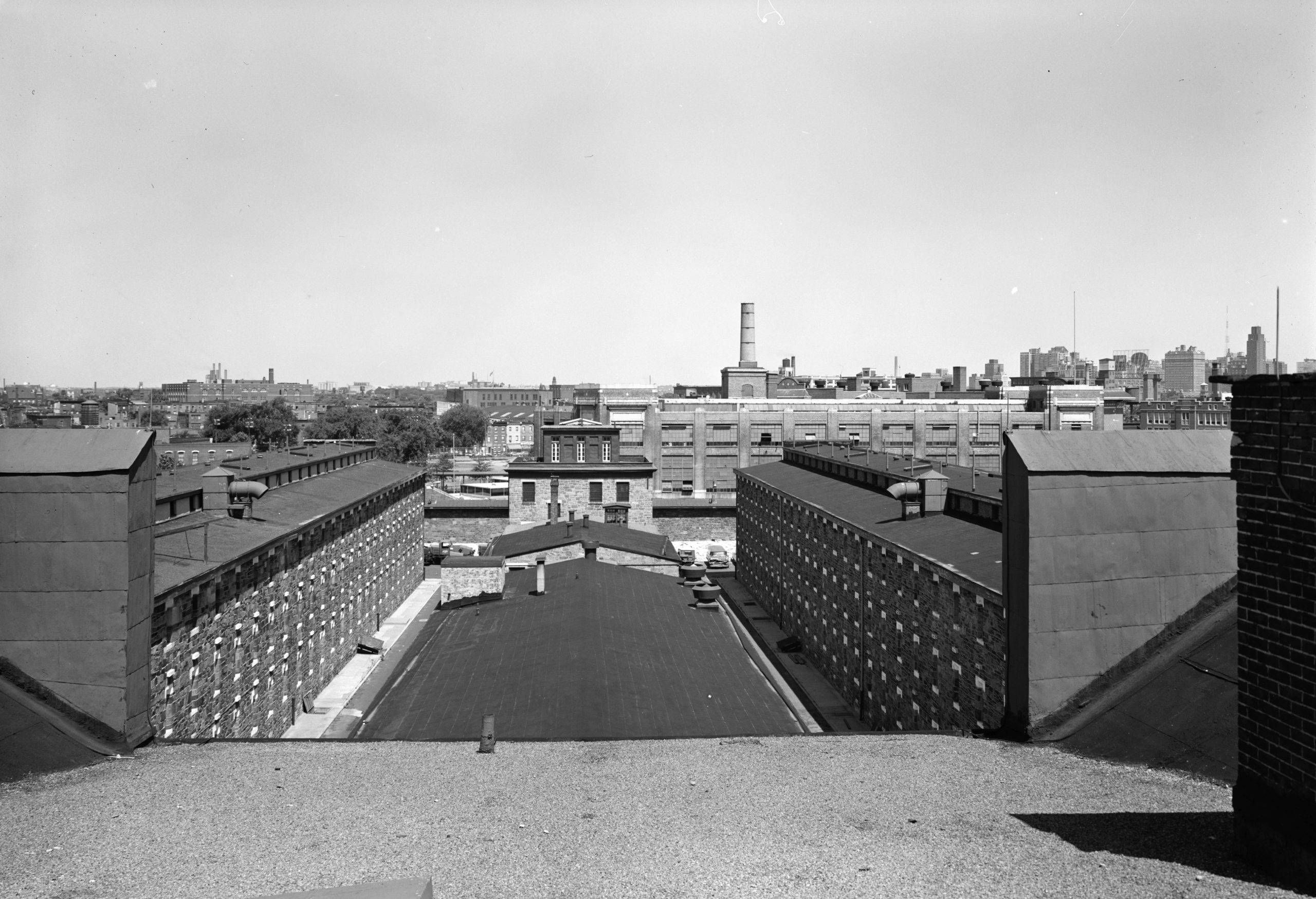
The Politics of Prayer in Prison
Andrew Skotnicki
Magite Historic / Alamy Stock Photo
I read a newspaper column many years ago by Garry Wills. He was writing about a priest and three peace activists, morally outraged by the bombing of Cambodia during the Vietnam War, who participated in a White House tour. At one point, they abruptly knelt, announced that the War was an affront to God, and began to pray the Our Father aloud. They were quickly seized by security personnel. However, when several school children among the visitors heard the prayer, they instinctively and innocently joined in its recital even as the protesters were being dragged away. Wills’s trenchant response was, “How dare they pray in the White House. You have to be invited to pray in the White House, and your prayer had better be flattering to the President.”1Wills, Garry. “How Dare They Pray in the White House!” Fellowship 39, no. 8 (08, 1973): 6. https://login.proxy.library.emory.edu/login?url=https://www.proquest.com/scholarly-journals/how-dare-they-pray-white-house/docview/1936514873/se-2.
I’m going to suggest that prayer in prison is no different than prayer in the White House. It is always to some degree a political act. It affirms how we are to live as individual and social beings in cognizance of and devotion to the transcendent. While the political nature of prayer includes the personal devotion of those confined in America’s detention centers, the internal dynamics of faith and conscience cannot be scrutinized and policed. The prayers of ministers of a given faith community are an entirely different matter. They have been given access to conduct public services in institutions where the constitutional freedoms protected by the “free exercise” clause of the constitution (more on that in a moment) meet head-on with the overriding security demands of the institution. As David Rothman suggests in his book, Conscience and Convenience, when freedom and security clash in a penal context, security always wins; and when treatment and coercion are in conflict, coercion always wins. Put another way, the demands of order and control and the policies enacted to attain them are intolerant of what I will call the prophetic aspects of traditions in which the social order is often held to withering scrutiny. Remembering Wills, then, one can only pray publicly in prison if one is invited and if one’s prayer is flattering or at least not deemed inflammatory, to the keepers of the kept.
A First Amendment digression
Federal courts and the Supreme Court have vacillated over the years on the level of scrutiny that justices employ regarding the Free Exercise Clause generally and its application to the rights of the imprisoned specifically. Since the 1940s, the court has developed three standards of review, ranging from low to high level scrutiny, on matters of religious conflict with the law. At the low level, the court will uphold a law if it is in pursuit of “legitimate” government interest and is reasonably related to that interest. Free exercise claimants win relatively few cases under this standard. With intermediate or heightened scrutiny, the court will uphold the challenged law if it represents “significant” government interest and is substantially related to that interest. Free exercise litigants win a considerable number of cases under this guideline. At the level of strict scrutiny, the court will uphold the law only if it reflects “compelling” government interest and is narrowly tailored to achieve that interest. Free exercise claimants win most of these cases.
This schema rightly implies that the legislative and judicial functions have often found themselves in tension regarding religious freedoms. One notable example was the Religious Freedom Restoration Act (RFRA) passed by Congress in 1993 that restored strict scrutiny in light of compelling state interest. In reaction, however, in City of Boerne v. Flores (1997), the Supreme Court declared the RFRA unconstitutional as applied to the states.
Passed in 1995, the Prison Litigation Reform Act (PLRA) prevents or deters prisoners from filing federal claims by banning some litigants and discouraging others. Would-be prisoner-plaintiffs now find themselves denied the opportunity to file their complaints due to conditions that would not apply to any other litigants.
There was some relaxation of this combative environment in the wake of the Religious Land Use and Institutional Persons Act (RLUIPA), passed by Congress in 2000, in which strict scrutiny was mandated in judging the right to worship claims of institutionalized persons. This bill also served to limit the restrictions placed upon the religious liberty of confined persons. The Nation of Islam had relied upon earlier strict scrutiny verdicts to secure greater tolerance for its own beliefs and practices, which have found their greatest locus for growth within the nation’s prisons. In Brown v McGinnis (NY 2d, 1962), incarcerated members of the Nation won the right to have services with a clergyman, but in O’Lone v Estate of Shabazz (1987), the Supreme Court determined that depriving Muslim inmates of Jumu’ah prayer was not a free exercise violation since a special burden would be placed on prison officials. The Shabazz ruling states that as long as prison regulations are “neutral and reasonable” they meet the requirements of the constitution. Still, RLUIPA served as a relief for numerous incarcerated persons seeking the freedom to practice their faith, and the Supreme Court gave its approval to the act in its ruling in Cutter v. Wilkinson (2005).
In a troubling turn of events that was both part and product of the mass incarceration phenomenon, Congress sought to reduce the volume of lawsuits by the incarcerated by barring prisoner-plaintiffs from federal court procedurally. Passed in 1995, the Prison Litigation Reform Act (PLRA) prevents or deters prisoners from filing federal claims by banning some litigants and discouraging others. Would-be prisoner-plaintiffs now find themselves denied the opportunity to file their complaints due to conditions that would not apply to any other litigants. If they lose their cases, they cannot be excused from paying costs and may also lose good time credit, extending their incarceration; however, if they win their cases, unlike all other litigants, they will not be allowed to collect costs. Prisoners must also meet special pleading requirements not imposed on other litigants. Whether this bill was instigated by penal officials or not, it clearly shows that the demands of institutional security and a quietist politics trump freedoms ordinarily allowed to citizens.
A prophet is never accepted
The foregoing reveals the continuing influence of the clause in the 13th Amendment that slavery and involuntary servitude, outlawed in civil society, are not prohibited for those serving time for criminal convictions. By extension, First Amendment guarantees and the vacillations of the scrutiny test must surrender to the day-to-day functioning of a given correctional facility. As Craig Haney, a psychologist who has done extensive work on the effects of confinement, phrases it, “without any mandate to provide positive programming . . . almost anything [can] be done in the name of institutional security.”2Craig Haney, Reforming Punishment: psychological limits to the pains of imprisonment (Washington, DC: American Psychological Association, 2006): 169. Thus, members of the clergy operating behind the walls are always treading a fine line between compliance with the institutional culture and fidelity to the aspects of their creed that call for social change.
This tension is related to the aforementioned prophetic dimension of religion. Prophets are not diviners or seers; they are agents of the Almighty compelled to speak to their wayward brethren who have deviated from the communal path prescribed in revelatory texts. While their message may include aspects of psychological individualism—the belief that, in a correctional context, one’s confinement is solely due to personal choices—prophets are compelled to condemn social practices that diminish the sacredness and freedom of all. Isaiah (58: 6) is a fitting example: “Here is the way I want you to fast. Set free those who are held by chains without any reason. Untie the ropes that hold people as slaves. Set free those who are crushed. Break every evil chain.”
Thomas Murton, former warden of the prison farms in Arkansas, clearly saw the conflict between prophetic proclamation and social control and its inevitable resolution in favor of the latter. He wrote of the Christian clergy who dominated the chaplaincy positions, but his words are by no means limited to a specific faith community: “[The prison minister] perhaps unwittingly at first, becomes an organ of control and oppression . . . serving the state, frequently in opposition to Christian precepts . . . Thus the mantle of [religion] protects the institution from criticism—at the expense, more often than not, of the very people the chaplain is ostensibly engaged to serve.”3T. O. Murton, “The Prison Chaplain: Prophet or Pretender?” The Reformed Journal (July 1979): 7-12 at 11.
Murton is inferring that access to the institution demands curtailing the religious message to fit within a hyper-vigilant atmosphere. Thus, as he suggests, perhaps innocently, or perhaps out of fear of reprisal, the politics of the pulpit become a tool to adjust the confined person to prison. This state of affairs muzzles prophetic denunciation of the institution in favor of an exaggerated emphasis on changing the person, not the social context of the prison or the social environments that exacerbate criminogenic tendencies. The data collected from studies of prison chaplains corroborates the abandonment of the prophetic aspects of religion in service to the state. An example is found in a study that reported that “the vast majority of chaplains (more than 90%) reported that helping inmates to adjust to prison” was an important or very important goal of their work.4J. Sundt, H. L. Dammer, and F. T. Cullen, “The Role of the Prison Chaplain in Offender Rehabilitation,” Journal of Offender Rehabilitation 35 (2002): 59-86 at 72. Another report was even more emphatic on the role of religion as a support for the penal mechanism: “Worship services and religious studies . . . reduce the number of inmates who must be supervised by housing area staff because inmates are being supervised by the chaplains . . . When custody staff and chaplains work together as members of an inmate management team . . . correctional facilities will be safer, more secure, and more orderly.”5J. R. Cook, “Chaplaincy: A Part of the Inmate Management Team,” in The State of Corrections: Proceedings of the Annual Conference of the American Correctional Association (Alexandria, VA: American Correctional Association, 1994): 61-64.
While there is nothing wrong with believing in sin and redemption, nor in the importance of the will in individual choice, the upshot of PF’s philosophy, hearkening back to psychological individualism mentioned earlier, is that the social, political, and economic systems bear no responsibility for the conditions that so often lead to delinquent behavior.
The conservative politics just referenced come to a head in the work of former Watergate conspirator, Charles Colson, and the creation of Prison Fellowship (PF), an evangelical Christian reform movement that opened America’s first faith-based prison unit in Texas in 1997. For Colson and his followers, prisons are an evangelical Christian mission field and their philosophy has proven successful in multiplying the number of faith-based units. A large reason for their success is that while Colson did not deliberately set aside rehabilitation, he did reject the medical treatment model that had proven a failure. Instead, he focused on religious (Christian) conversion and a belief that men and women are in prison due to sin: “Getting out of sin. That’s what this is all about. The solution to crime is no different from . . . the human predicament as a whole. We are at odds with God.”6Charles Colson, Justice That Restores (Wheaton, IL: Tyndale, 2001): 90.
While there is nothing wrong with believing in sin and redemption, nor in the importance of the will in individual choice, the upshot of PF’s philosophy, hearkening back to psychological individualism mentioned earlier, is that the social, political, and economic systems bear no responsibility for the conditions that so often lead to delinquent behavior. Indeed, Colson built PF on the belief that retribution and deterrence are the principal foundations of the correctional enterprise. In other words, the prophetic dimension of religion generally and in Christianity particularly is abandoned in favor of adapting the imprisoned to both the social conditions in which they were raised and to the conditions of the penal facility to which they have been sentenced. Nothing could be more welcome to penal officials.
This essay has argued that prayer in prison is political in all forms but only a conservative politics that deflects criticism from the criminal justice system can be tolerated in public assemblies. The prayer of the prophets, remembering Amos (5:24), that censures those political structures that oppress the weak and the needy and cries for justice to roll down like a mighty stream is as anachronous behind bars as it is in the White House. ♦

Andrew Skotnicki teaches theological and criminological ethics at Manhattan College in New York City. His most recent book is Injustice and Prophecy in the Age of Mass Incarceration: The Politics of Sanity (Bristol University Press, 2022).
Recommended Citation
Skotnicki, Andrew. “The Politics of Prayer in Prison.” Canopy Forum, April 8, 2023. https://canopyforum.org/2023/04/08/the-politics-of-prayer-in-prison/.

